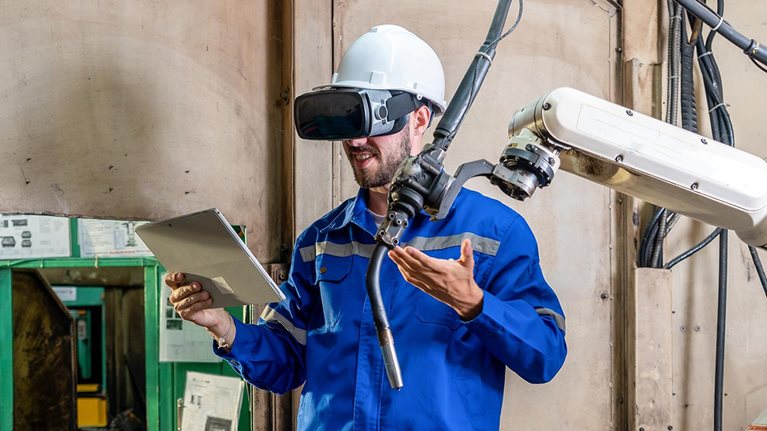I belong. I contribute. I have a future here.
When frontline production workers are saying that, companies can rest assured they’re doing something right. Every employer in the production ecosystem should aspire to cultivate these sentiments. And it’s not just a matter of fuzzy feelings—companies thrive when their workers do, and vice versa. Amid today’s incredibly competitive market for frontline production talent, there’s little margin for error.
Industry continues to undergo rapid transformations in a new age of intelligent operations. While prioritizing people has always been important, success in today’s production value chain hinges on recruiting, retaining, and developing workers with advanced digital skills in a competitive talent marketplace—and keeping them engaged, committed, and satisfied. It’s no easy task.
A global initiative to explore and share talent innovations
Success in this transforming production environment requires a fundamental mindset shift for leaders of organizations that rely on frontline talent to serve customers. Leaders must go from viewing frontline talent as a cost to understanding it as an investment.
This essential shift is the focus of the Frontline Talent of the Future Initiative, a collaboration between the World Economic Forum and McKinsey & Company. The Initiative explores how leading companies are deploying frontline innovations that support productivity, stability, or a combination of both. It was modeled after the Global Lighthouse Network (GLN), also a joint undertaking by the Forum and McKinsey, designed to recognize production pacesetters leading the Fourth Industrial Revolution around the world (see sidebar, “Understanding the evolving talent imperative”).
The Initiative’s pilot program involved a comprehensive survey and other data-gathering efforts, site visits, and conversations with nine innovative talent leaders across a range of production sectors and geographies—from consumer packaged goods (CPG) to industrials to energy, and from the Americas, Europe, and Asia. Each site shared its motivations for investing in talent transformation, along with specific innovations that led to performance gains in key metrics.
A direct line to impact
Much has been written on the topic of workforce engagement and the future of work. So what sets the Frontline Talent of the Future Initiative apart from the rest? It comes down to impact: the Initiative has intentionally tied each talent innovation directly to a productivity or stability outcome.
This article highlights the drivers of talent capability and provides a look at just a few of the most compelling talent innovations. To explore them in more depth—and, particular, to learn about the fascinating talent innovations at Initiative sites—read this 2025 white paper.
Five principal drivers of frontline challenges
When asked what lies behind frontline challenges felt by many (if not all) employers, the Frontline Talent of the Future Initiative identified five principal drivers:
- Talent shortages. Demand for talent outpaces supply in much of the world, even in developed economies.
- Widening skill gaps. As production moves from manual to digital, companies are struggling to find workers with the requisite skills.
- Evolving worker needs. Many employers underestimate the degree to which today’s frontline workers are looking for a discernible career path.
- Overburdened supervisors. Roughly 40 percent of middle managers report burnout, with limited time for genuine “people leadership.”
- Insufficient rewards, recognition, and incentives. While pay matters, so do nonmonetary factors that go beyond the transactional.
The mindset shift needed
The Frontline Talent of the Future Initiative has identified a common mindset among all leading organizations: that investing in talent allows them to shape their own destiny. But what does “investing in talent” actually mean? It comes down to reframing the mindset around talent—and thinking of talent not as a cost center, but rather as an investment along the lines of how the company approaches capex.
Six essential talent capabilities
To enable the mindset shift, leading companies are realizing that talent strategy is no longer merely an enabler to overall business strategy—rather, people strategy is the strategy. Knowing the art of the possible in talent investments is the first step to achieving the culture shift. Along with compensation, leading companies are making targeted investments across six critical talent capabilities. The Frontline Talent of the Future Initiative explored how organizations are deploying talent innovations across these six capabilities. (A glimpse at an example of each is provided here, but these are explored in greater depth in the white paper.)
1. Work design and safety
Leaders reimagine frontline work to create safe, productive workspaces and processes. Western Digital in Thailand developed a digital control room to transform 46 percent of job roles, shifting many to higher skill levels. Unilever USA implemented agile organizational restructuring by assessing the available talent pool and adjusting site roles to meet current business needs. This reduced attrition by 68 percent while developing local management.
2. Talent planning
Innovative companies work to understand the frontline skills needed at both the organization and site level, matching demand and supply through dynamic scheduling. Haier in China developed a “virtual industrial engineering system” that uses AI algorithms to allocate tasks and assign workers to balance the line based on real-time circumstances, including workers available and their skill levels. The system boosted operator satisfaction while improving the overall line utilization rate by 20 percentage points.
3. Attraction and onboarding
Leading organizations use innovative approaches to find and activate the next generation of frontline talent. Unilever Brazil was intentional about offering opportunities for underrepresented groups. The company partnered with an organization to seek job candidates, then built a pilot program that facilitated hiring through language expansion, accelerated timelines, a stipend-supported onboarding process, and comprehensive training and learning components. This effort increased minority and female hiring, improved minority promotion rates by 15 percentage points, and improved retention rates by 25 percentage points.
4. Talent development
Talent leaders build distinctive frontline capabilities for operators and supervisors. Aramco used gamification to transform training for a young workforce, engaging them with immersive, multiplayer collaborations for operations training, leadership development, onboarding, and topics around safety and well-being. Simulation-based preventive maintenance training, enabled through the use of virtual reality (VR) technology, replicates rigorous conditions and real-life scenarios. The initiative boosted technician competency and cut the maintenance backlog by 11 percent.
Unilever’s Pouso Alegre site in Brazil boosted the autonomy of technical operators by providing three months of intensive technical training, reducing dependency on maintenance teams. The program enhanced skills, improved efficiency, and enculturated continuous improvement. It also increased overall equipment effectiveness (OEE) by 4 percent, reduced breakdowns due to basic conditions by 42 percent, and decreased maintenance activities by 35 percent.
5. Talent effectiveness
Leaders effectively manage performance for operators and supervisors, driving the right behaviors to achieve aspirations. Unilever in Kilbourn, USA, created a performance-based rewards framework to energize its unionized frontline workforce through gamification. Achieving site goals, shift goals, and individual goals earns points, which can be redeemed for gift cards. Site leaders award points at biweekly town halls, which also provide a venue for sharing ideas. Implementation boosted OEE by 16 percent, reduced product waste by 34 percent, improved employee engagement by 26 percent, and reduced the absenteeism rate by 48 percent.
6. Culture and experience
Talent innovators define and deliver a compelling employee value proposition (EVP). Nestlé Brazil, aiming to support deaf and hard-of-hearing employees, retrofitted visual machine alerts while implementing education and integration efforts. The company hired a fulltime Brazilian Sign Language (Libras) interpreter, offered Libras classes to all managers and supervisors, and translated all training and communication into Libras. The site trained over 200 employees in Libras, boosting inclusion for the approximately 6 percent of the workforce who are deaf or hard of hearing.
Prioritize investments based on a localized approach
In many cases, machines and production systems can be standardized across sites, leading to operating efficiencies and scale benefits. This approach is inadequate for talent, however. Instead, leading organizations are engaging in holistic diagnostics that assess local labor markets where they operate to build informed, differentiated strategies for each. This is true for multinationals, as well as smaller organizations operating in just one or two sites.
Unilever, for example, uses localized investments to meet different talent market imperatives at its sites across the globe. At its Kilburn, Chicago, USA, site, it focused on improving retention, engagement, and operational efficiency. Meanwhile, at its Tianjin, China, site, the focus was on attraction, onboarding, and talent development to meet rapid business growth.
McKinsey research indicates that where a particular labor market is situated along two axes—projected labor supply-demand balance, and projected labor supply growth—will position it within one of four environments, each compelling a different approach. These factors can inform whether the site-level talent strategy should be oriented around productivity, transition, stability, or distinctiveness.
Operationalizing frontline talent investment
Understanding differentiated local labor markets and assessing maturity across the six talent capabilities mentioned can help companies understand their existing EVP and make adjustments in an informed manner. Combined with assessment of critical productivity metrics (such as OEE and yield) and stability metrics (such as absenteeism, turnover, vacancy, and time to fill), these insights can help companies improve in both categories. McKinsey research has found that the investment required to implement talent innovations typically generates 3 to 5x ROI within one to two years. But operationalizing frontline talent investment requires the right processes and teams.
A structured talent investment process
Once a company determines the unique needs of its workforce and talent pipeline at a given site, it can build a talent process that emulates capital expenses. This can and should be done largely at the local level—indeed, 56 percent of the talent innovations explored in the Initiative were developed at the site level—but with sufficient approval and authority structures enabled by headquarters. It is also vital that site leadership is committed to being able to show impact. That begins with identifying the leading and lagging indicators for each investment and then tracking and measuring ROI against these indicators.
Cross-functional teams
Dedicated cross-functional leadership teams are essential for operationalizing talent investment. The mentality should be building solutions with, rather than for, the front line. This requires getting over the mindset block that talent is an HR concern only—talent innovations should be a collaborative effort between leaders of operations, finance, and HR. One of the most notable aspects of Frontline Talent of the Future Initiative pilot sites was that they all prioritize employee involvement in ideation. From town halls to hackathons, various approaches keep those closest to the work involved in talent innovations.
Learn more and level up
The future of production is all about people—believing in them, investing in them, and supporting their path into a redefined world of work. The moment calls for a renewed focus on the frontline workers who comprise the beating heart of industry, and this renewal is predicated on a fundamental mindset shift about talent. Companies interested in enabling this mindset shift—from thinking of talent as a cost center to thinking of talent as a crucial investment—should examine the white paper to learn more.


